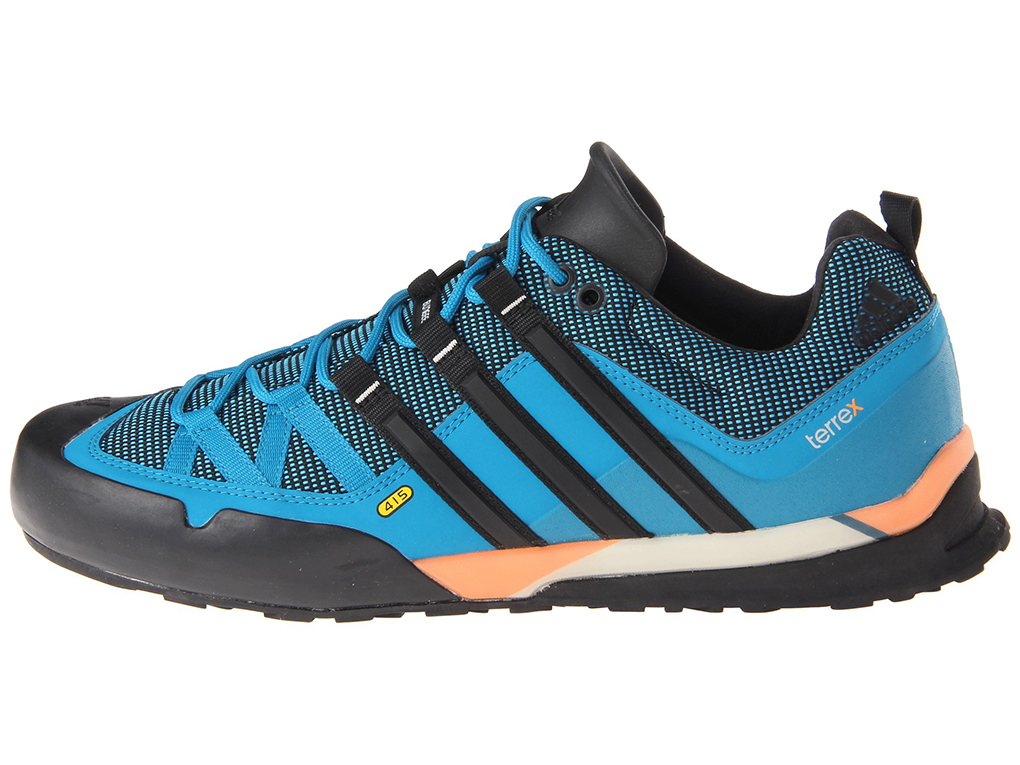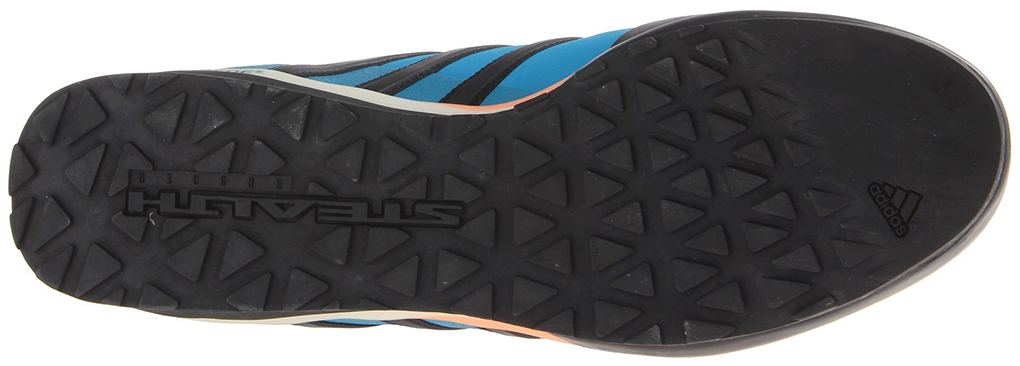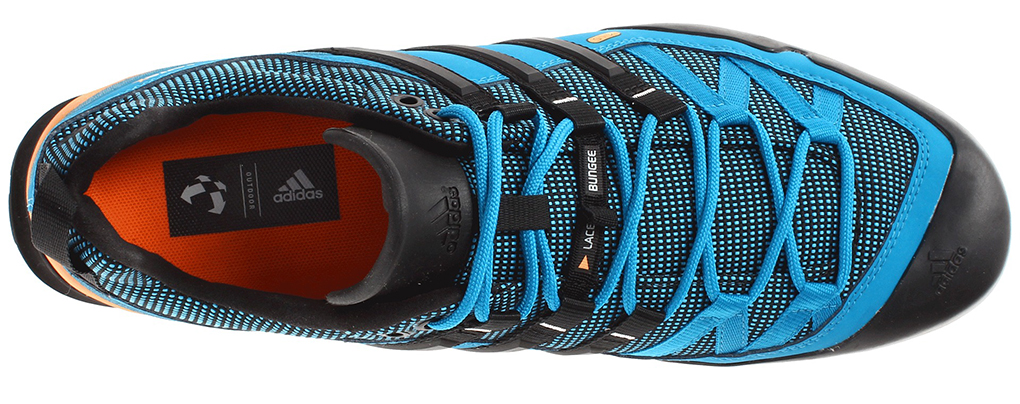
Adidas Terrex Solo
Size tested: 13
Reviewer’s Feet: Size 13 street shoe, medium-volume, low arch, neutral gait
Materials:
- Abrasion-resistant mesh and synthetic upper
- Rubber toe bumper
- Stealth rubber outsole
Test Locations: Wind River Range and Big Horn National Forest, WY; South Platte and Front Range, CO
Days tested: ~ 40
The Terrex Solo approach shoe is a prominent part of Adidas’ fairly recent entry into the world of technical footwear and outerwear. While Adidas may seem to be a surprising player in the climbing and hiking world, their acquisition of Five Ten and the addition of well-known climbers to their sponsored team indicate a commitment to this space.
Adidas’ “Terrex” line of shoes is fairly confusing, and includes the Solo (the subject of this review), but also the Swift, Swift Solo, Swift R, and Fast X—both low cut and high top.
It definitely took some time to fully figure out which niche each of those shoes was intended to occupy. I’m not going to break down the whole line, just know for now that the “Solo” iterations of various Terrex shoes are squarely in the approach category, while the other models skew toward either hiking or trail running.
Ok, on to the Terrex Solo.
At first glance, the upper of the Terrex Solo is a bit unorthodox for an approach shoe; it looks more like something you’d see on a basketball court than in the backcountry.
A closer inspection reveals that it does have the standard features of an approach shoe, including the sticky rubber toe wrap that, for whatever reason, seems to be the one thing required for an approach shoe to be recognized as such.
The Rubber
This toe wrap and the sole it extends from are made of Stealth rubber, which will be familiar to wearers of FiveTen shoes. Stealth is a great rubber, and represents a huge step up from the TRAXION rubber that appeared on earlier generations of the Terrex Solo (and still appears on some other shoes in Adidas’ line).

The TRAXION rubber looks, feels, and performs too much like plastic to be of much practical use, and I was relieved to see the move to the more effective Stealth. If you’ve had previous experiences with the Terrex Solo (or anything else with TRAXION), it would be worth revisiting the shoe.
The Upper & Tongue
The upper on the Terrex is a combination mesh/synthetic that is both flexible and comfortable. The molded tongue (a soft rubber which holds a curved shape) caught my eye when I first wore the shoe, but I didn’t notice it at all while wearing the Terrex Solo, which is just about the best thing you can say about a tongue.

Having said that, I do think there are ways in which Adidas could continue to improve the Terrex Solo. I’ve tested a lot of approach shoes in the last couple years, and the fact is that the competition in this category is fierce. There are a lot of good approach shoes out there, and you have to really be dialed if you’re going to stand out. So I’ll start with a few things that I really like about the Terrex Solo, then outline a few things that I think could be improved upon.
The Sole
The sole of the Terrex Solo is heavily cushioned, and the shoe has a soft strike and is still comfortable after hours of wear.

Durability
The upper, the sole, and the stitching on the shoe have held up well to standard trail use and scrambling. But given that it’s mesh, the upper is a little bit vulnerable to abrasion.
Adidas claims the upper material is abrasion-resistant, and relative to most mesh/synthetics you’ll encounter, this is true. It’s going to live much longer than, say, the Patagonia Rover if you’re stuffing it in cracks, but jamming the Terrex Solo in cracks (particularly coarse granite) will start to abrad the synthetic and mesh materials. It’s not as abrasion resistant as leather.

Hi Dave, 1 Question: How well does the sole grip on different wet grounds? Thx.
Good question: it does pretty well on wet ground overall. Granted, sticky rubber of the sort found on approach shoes really loses it’s magic once the rock gets wet, but the sole pattern on the Terrex (almost tessellated triangles, sort of like other “dot rubber” soles) is good at finding ripples and such in the rock. The smooth toe, which is good in dry conditions, suffers some when it rains, but not dramatically more so than other approach shoes. I’d sum up like this: If the Terrex fits you well and is a good shoe for what you’re interested in doing, it’s performance on wet rock shouldn’t deter you.
Thanks for the update. Yesterday, I bought the “big brother” of the solo, the scope. I was told that it would be the better choice for longer hiking, because the heelpart is more lifted. So I did a 4h Hike 5500 ft. up (1700 meters) and now I am not sure, if I choosed the right shoe: The Scope’s grip is fabolous, the precison is good (for that much cushioning) but the weight and the sole’s stiffness seem a little over the top for what I was asking (alpine approach, rocks, allround hiking, scrambling in not-so-wet conditions, light baggage). The sole is as stiff as in my mountain boots. Maybe it will soften up a little after a few more walks and scrambles. I am pretty sure footed, so for the moment I think, the solo would have been enough as a complement to my mountain boots. On the other side: I was quite impressed by the soles profile and the heavy-terrain capabilities of the scope. Maybe I will appreciate that in more challenging hikes and scrambles than yesterdays…
Thanks for the review! How do you think these shoes would do scrambling on routes with lots of scree?
Travis,
I had no problems with them in scree. If by “scree” you mean small grain sizes, closer to gravel, then these would charge up that stuff (provided you don’t mind dealing with a heavier shoe). If you’re thinking about smaller boulder-sized talus, then I might prefer something that’s a bit lighter and more precise for rock hopping, etc. In general, scree won’t shut these down.
Great review, thanks.
I’m wondering what you thought of the shoes when it comes to flexibility and ‘climbability.’ I’m used to the evolv cruzers and I really enjoy them for their sensitivity and relative sticky rubber. However, I’m hoping to buy a bit more of a durable approach shoe that still maintains the ability to climb pretty well since I tend to enjoy climbing routes as hard as 5.5 in my cruzers. When it comes to flexibility it seems unlikely that you’ll find anything more flexible than the cruzers but I’m wondering if these are even close or are they significantly more rigid and less sensitive?